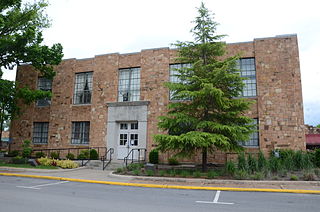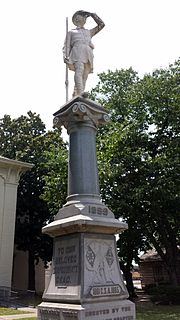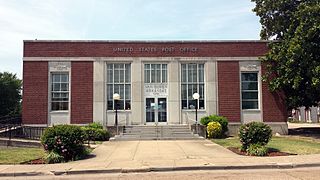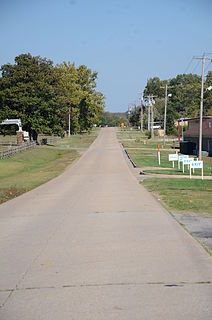
Van Buren County is a county located in the U.S. state of Iowa. As of the 2010 census, the population was 7,570. The county seat is Keosauqua, which contains the oldest continuously operational courthouse in the state of Iowa, and second oldest in the United States.

Crawford County is a county located in the Ozarks region of the U.S. state of Arkansas. As of the 2010 census, the population was 61,948, making it the 12th-most populous of Arkansas's 75 counties. The county seat and largest city is Van Buren. Crawford County was formed on October 18, 1820 from the former Lovely County and Indian Territory, and was named for William H. Crawford, the United States Secretary of War in 1815.

Van Buren is the second largest city in the Fort Smith, Arkansas-Oklahoma Metropolitan Statistical Area and the county seat of Crawford County, Arkansas, United States. The city is located directly northeast of Fort Smith at the Interstate 40 - Interstate 540 junction. The city was incorporated in 1845 and as of the 2010 census had a population of 22,791, ranking it as the state's 22nd largest city, behind Searcy.
Clarke House may refer to:

The Van Buren County Courthouse is located at the corner of Griggs and Main Streets in downtown Clinton, Arkansas, the county seat of Van Buren County. It is a two-story masonry structure, built primarily out of local stone. Its main facade is five bays wide, each flanked by broad sections that project a small amount. The main entrance is in the center bay, with a concrete surround of pilasters and a tall corniced entablature. It was built in 1934 with funding support from the federal Works Progress Administration, and was the county's third courthouse to be located in Clinton.
Van Buren House may refer to:

The Van Buren County Courthouse located in Keosauqua, Iowa, United States, was built in 1843. It was listed on the National Register of Historic Places in 1977 as a part of the County Courthouses in Iowa Thematic Resource. It is the only building the county has used as its courthouse, and it is the oldest courthouse in Iowa. In 1845 the courthouse served as the location for a trial resulting in the first death penalty in Iowa history.

Charles Emlen Bell (1858–1932), often known as C.E. Bell, was an American architect of Council Bluffs, Iowa and Minneapolis, Minnesota. He worked alone and in partnership with John H. Kent and Menno S. Detweiler. He also worked as part of Bell, Tyrie and Chapman. A number of his works are listed on the U.S. National Register of Historic Places.
Frank E. Wetherell (1869-1961) was an architect in the U.S. state of Iowa who worked during 1892–1931. He founded the second oldest architectural firm in the state in Des Moines, Iowa, in 1905.

Van Ryn & DeGelleke was an architectural firm in Wisconsin. It was a partnership of Henry J. Van Ryn and Gerrit Jacob DeGelleke, both of whom grew up in Milwaukee.

The Van Buren Historic District encompasses eight blocks of historic buildings along Main Street in Van Buren, Arkansas. Many of the structures are pre-1920 Victorian and Italianate buildings closely related to the history of commerce in the city. Positioned between the city's train depot and the Arkansas River, the businesses constituting the Van Buren Historic District have played a vital role in the history and economy of the city and region. The district was placed on the National Register of Historic Places as a National Historic District on April 30, 1976.

The Van Buren Confederate Monument is located in front of the Crawford County Courthouse in Van Buren, Arkansas. Built in 1899 by the Mary Lee Chapter of the United Daughters of the Confederacy, the structure was initially erected in Fairview Cemetery. Honoring Confederate dead from the Battle of Pea Ridge, Battle of Prairie Grove, and the Battle of Wilson's Creek, the Sons of the Confederacy requested the memorial be relocated to the courthouse lawn in 1906, and it has remained there ever since. The monument was listed on the National Register of Historic Places in 1996 as part of the Civil War Commemorative Sculpture Multiple Property Submission.

The Van Buren County Courthouse is a government building located at 212 East Paw Paw Street in Paw Paw, Michigan. It was designated a Michigan State Historic Site in 1977 and listed on the National Register of Historic Places in 1979.

The Paw Paw City Hall is a government building located at 111 East Michigan Avenue in Paw Paw, Michigan. It was designated a Michigan State Historic Site in 1971 and listed on the National Register of Historic Places in 1972.

The Drennen-Scott House is a historic house museum on North 3rd Street in Van Buren, Arkansas. It is a single-story log structure, finished in clapboards, with a side-gable roof that has a slight bell-cast shape due to the projection of the roof over the front porch that extends across the width of its main block. The house was built in 1836 by John Drennen, one of Van Buren's first settlers. Drennen and his brother-in-law David Thompson were responsible for platting the town, and Drennen was politically active, serving in the territorial and state legislatures, and at the state constitutional convention. The house remained in the hands of Drennen descendants until it was acquired by the University of Arkansas at Fort Smith, which operates it as a house museum.

The Van Buren Post Office is located at 22 South 7th Street in Van Buren, Arkansas. It is a single-story brick and stone building, with restrained Art Deco styling. The main entrance is topped by a panel with aluminum signage identifying the building, with a large window above. It is flanked by tall pilasters, beyond which are tall windows and another pair of pilasters. The outer bays of the facade, set off from the center, have windows topped by decorative Art Deco panels. The post office was built in 1936, and features a mural by E. Martin Hennings, that was executed in 1940 with funding from the Treasury Department's Section of Fine Arts.

Old U.S. 64-Van Buren Segment is a stretch of historic roadway in Van Buren, Arkansas. Now designated Oak Lane, this stretch of concrete road was built in 1928 as part of the original alignment of U.S. Route 64 (US 64), whose current alignment travels to the south. This stretch of road is about 0.65 miles (1.05 km) long and 18 feet (5.5 m) wide, carrying two lanes of traffic with no shoulder. It is made out of a tan-colored aggregate mixed with concrete. This segment was part of the first concrete-paved road in Crawford County.

The Clinton Commercial Historic District encompasses the historic commercial center of Clinton, Arkansas. It encompasses a roughly triangular area, bounded by Main Street, Moss Street, and United States Route 65B, extending northwest along 65B as far as Oak Street. This area's development began in the mid-19th century, but most of its buildings date from the first half of the 20th century, representing a diversity of architectural styles popular in that time period. Notable buildings in the district include the Van Buren County Courthouse and the Walter Patterson Filling Station.














